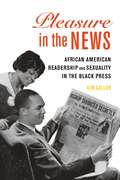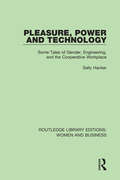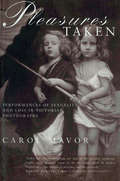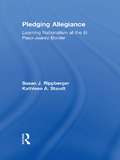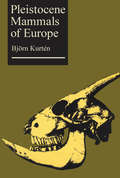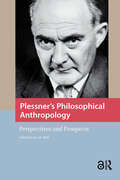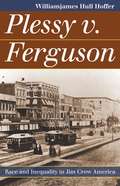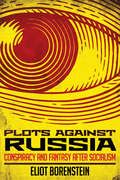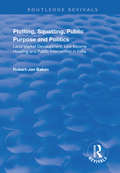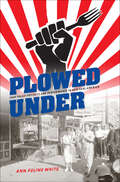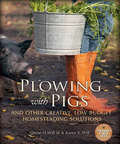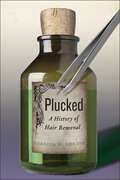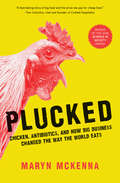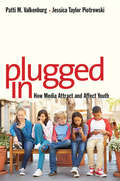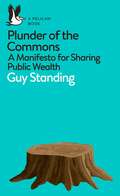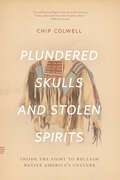- Table View
- List View
Pleasure and Efficacy: Of Pen Names, Cover Versions, and Other Trans Techniques
by Grace Elisabeth LaveryA leading trans scholar and activist explores cultural representations of gender transition in the modern periodIn Pleasure and Efficacy, Grace Lavery investigates gender transition as it has been experienced and represented in the modern period. Considering examples that range from the novels of George Eliot to the psychoanalytic practice of Sigmund Freud to marriage manuals by Marie Stopes, Lavery explores the skepticism found in such works about whether it is truly possible to change one’s sex. This ambivalence, she argues, has contributed to both antitrans oppression and the civil rights claims with which trans people have confronted it. Lavery examines what she terms “trans pragmatism”—the ways that trans people resist medicalization and pathologization to achieve pleasure and freedom. Trans pragmatism, she writes, affirms that transition works, that it is possible, and that it happens.With Eliot and Freud as the guiding geniuses of the book, Lavery covers a vast range of modern culture—poetry, prose, criticism, philosophy, fiction, cinema, pop music, pornography, and memes. Since transition takes people out of one genre and deposits them in another, she suggests, it should be no surprise that a cultural history of gender transition will also provide, by accident, a history of genre transition. Considering the concept of technique and its associations with feminine craftiness, as opposed to masculine freedom, Lavery argues that techniques of giving and receiving pleasure are essential to the possibility of trans feminist thriving—even as they are suppressed by patriarchal and antitrans feminist philosophies. Contesting claims for the impossibility of transition, she offers a counterhistory of tricks and techniques, passed on by women to women, that comprises a body of knowledge written in the margins of history.
Pleasure and Power in Nazi Germany
by Pamela E. Swett Corey Ross Fabrice D’almeidaAlthough we associate the Third Reich above all with suffering, pain and fear, pleasure played a central role in its social and cultural dynamics. This book explores the relationship between the rationing of pleasures as a means of political stabilization and the pressure on the Nazi regime to cater to popular cultural expectations.
Pleasure in the News: African American Readership and Sexuality in the Black Press (New Black Studies Series #1)
by Kim GallonCritics often chastised the twentieth-century black press for focusing on sex and scandal rather than African American achievements. In Pleasure in the News, Kim Gallon takes an opposing stance—arguing that African American newspapers fostered black sexual expression, agency, and identity. <P><P> Gallon discusses how journalists and editors created black sexual publics that offered everyday African Americans opportunities to discuss sexual topics that exposed class and gender tensions. While black churches and black schools often encouraged sexual restraint, the black press printed stories that complicated notions about respectability. Sensational coverage also expanded African American women’s sexual consciousness and demonstrated the tenuous position of female impersonators, black gay men, and black lesbians in early twentieth African American urban communities. <P><P> Informative and empowering, Pleasure in the News redefines the significance of the black press in African American history and advancement while shedding light on the important cultural and social role that sexuality played in the power of the black press.
Pleasure, Power and Technology: Some Tales of Gender, Engineering, and the Cooperative Workplace (Routledge Library Editions: Women and Business #5)
by Sally HackerHow are the pleasures of making things work turned into processes of domination? Are there links between gender and military institutions? Does eroticism have something to do with engineering? In this book, first published in 1989, Sally Hacker explores the answers to these and other provocative questions about our attitudes toward work and leisure. Drawing from her broad experience as a sociologist, feminist and student of engineering, Hacker helps us to understand the impact of technology on our society and how feminist principles can be used to make work life more egalitarian and more humane. In the first part of the book, the author examines various examples of the masculinization of power, ranging from military institutions to the mechanisation of farm labour, computer technology and affirmative action. In the second part, Hacker presents the results of her research on Mondragon, the world’s largest cooperative workplace, located in Spain. Hacker reaches surprising conclusions about gender and technology at Mondragon, where, in spite of the community’s egalitarian philosophy, gender inequality was as pervasive as in capitalist and socialist systems.
Pleasures Taken: Performances of Sexuality and Loss in Victorian Photographs
by Carol MavorLewis Carroll's photographs of young girls, Julia Margaret Cameron's photographs of Madonnas and the photographs of Hannah Cullwick, "maid of all work", pictured in masquerade - Carol Mavor addresses the erotic possibilities of these images, exploring not ony the sexualities of the girls, maids and Madonnas, but the pleasures taken - by the viewer, the photographer, the model - in imagining these sexualities.
Pledged: The Secret Life of Sororities
by Alexandra RobbinsHere we find lushes, trollops, bigots, sadists, masochists, anorexics, and those made mad by unrequited lust for election as Prom Queen. Journalist Robbins takes a novelistic approach as she joins the "sisters" of a real-life sorority to prove that all that has been said about their entrance standards, rituals, systems of judgment and punishment, over-the-top lifestyle, and lifelong loyalty is true. She follows the stories of several women who could be considered ambitious, attractive, and intelligent as they make choices based on unhealthy regard for themselves and others. The subtext here is that these women will go on to be business and civic leaders. Annotation ©2004 Book News, Inc., Portland, OR (booknews.com)
Pledged: The Secret Life of Sororities
by Alexandra RobbinsHere we find lushes, trollops, bigots, sadists, masochists, anorexics, and those made mad by unrequited lust for election as Prom Queen. Journalist Robbins takes a novelistic approach as she joins the "sisters" of a real-life sorority to prove that all that has been said about their entrance standards, rituals, systems of judgment and punishment, over-the-top lifestyle, and lifelong loyalty is true. She follows the stories of several women who could be considered ambitious, attractive, and intelligent as they make choices based on unhealthy regard for themselves and others. The subtext here is that these women will go on to be business and civic leaders.
Pledging Allegiance: Learning Nationalism at the El Paso-Juarez Border
by Susan J. Rippberger Kathleen A. StaudtOffering a critical ethnography of education at the U.S.-Mexico border, Pledging Allegiance explores how public schools teach cultural and national values explicitly and implicitly. Susan J. Rippberger and Kathleen A. Staudt illuminate the complex overlays of culture and learning through the eyes of students, teachers, and administrators in U.S. and Mexican schools. This book examines nationalism and civic ritual, bilingualism, technology, and classroom organization to discover how educators along the border impart senses of national and cultural identity to their students.
Pleistocene Mammals of Europe
by Bjorn KurtenThis book provides a comprehensive treatment of all the Pleistocene species in Europe, classified according to modern taxonomic principles. For each species there is a description of its descent and migration history, its range, and its mode of life. The first version of this book was a semipopular paperback in the Swedish Aldus series.
Plenty-Coups, Chief of the Crows: The Life Story of a Great Indian
by Frank B. LindermanIn his old age, Plenty-Coups (1848-1932), the last hereditary chief of the Crow Indians, told the moving story of his life to Frank B. Linderman, a well-known western writer who had befriended him.First published in 1930, Plenty-Coups is a classic account of the nomadic, spiritual, and warring life of Plains Indians before they were forced onto reservations. Plenty-Coups tells of the great triumphs and struggles of his own life: his powerful medicine dreams, marriage, raiding and counting coups against the Lakotas, fighting alongside the U.S. Army, and the death of General Custer.
Plenty-coups: Chief of the Crows
by Frank B. LindermanIn his old age, Plenty-coups (1848-1932), the last hereditary chief of the Crow Indians, told the moving story of his life to Frank B. Linderman, the well-known western writer who had befriended him.
Plessner's Philosophical Anthropology: Perspectives and Prospects
by Jos De MulHelmuth Plessner (1892-1985) was one of the founders of philosophical anthropology, and his book The Stages of the Organic and Man, first published in 1928, has inspired generations of philosophers, biologists, social scientists, and humanities scholars. This volume offers the first substantial introduction to Plessner's philosophical anthropology in English, not only setting it in context with such familiar figures as Bergson, Cassirer, and Merleau-Ponty, but also showing Plessner's relevance to contemporary discussions in a wide variety of fields in the humanities and sciences.
Plessy V. Ferguson: Race And Inequality In Jim Crow America
by WilliamJames Hull HofferSix decades before Rosa Parks boarded her fateful bus, another traveler in the Deep South tried to strike a blow against racial discrimination--but ultimately fell short of that goal, leading to the Supreme Court's landmark 1896 decision in Plessy v. Ferguson. Now Williamjames Hull Hoffer vividly details the origins, litigation, opinions, and aftermath of this notorious case. In response to the passage of the Louisiana Separate Car Act of 1890, which prescribed "equal but separate accommodations" on public transportation, a group called the Committee of Citizens decided to challenge its constitutionality. At a pre-selected time and place, Homer Plessy, on behalf of the committee, boarded a train car set aside for whites, announced his non-white racial identity, and was immediately arrested. The legal deliberations that followed eventually led to the Court's 7-1 decision in Plessy, which upheld both the Louisiana statute and the state's police powers. It also helped create a Jim Crow system that would last deep into the twentieth century, until Brown v. Board of Education in 1954 and other cases helped overturn it. Hoffer's readable study synthesizes past work on this landmark case, while also shedding new light on its proceedings and often-neglected historical contexts. From the streets of New Orleans' Faubourg Trem district to the justices' chambers at the Supreme Court, he breathes new life into the opposing forces, dissecting their arguments to clarify one of the most important, controversial, and socially revealing cases in American law. He particularly focuses on Justice Henry Billings Brown's ruling that the statute's "equal, but separate" condition was a sufficient constitutional standard for equality, and on Justice John Marshall Harlan's classic dissent, in which he stated, "Our Constitution is color-blind, and neither knows nor tolerates classes among its citizens. " Hoffer's compelling reconstruction illuminates the controversies and impact of Plessy v. Ferguson for a new generation of students and other interested readers. It also pays tribute to a group of little known heroes from the Deep South who failed to hold back the tide of racial segregation but nevertheless laid the groundwork for a less divided America.
Plots against Russia: Conspiracy and Fantasy after Socialism
by Eliot BorensteinIn this original and timely assessment of cultural expressions of paranoia in contemporary Russia, Eliot Borenstein samples popular fiction, movies, television shows, public political pronouncements, internet discussions, blogs, and religious tracts to build a sense of the deep historical and cultural roots of konspirologiia that run through Russian life. Plots against Russia reveals through dramatic and exciting storytelling that conspiracy and melodrama are entirely equal-opportunity in modern Russia, manifesting themselves among both pro-Putin elites and his political opposition. As Borenstein shows, this paranoid fantasy until recently characterized only the marginal and the irrelevant. Now, through its embodiment in pop culture, the expressions of a conspiratorial worldview are seen everywhere. Plots against Russia is an important contribution to the fields of Russian literary and cultural studies from one of its preeminent voices.
Plotting, Squatting, Public Purpose and Politics: Land Market Development, Low Income Housing and Public Intervention in India (Routledge Revivals Ser.)
by Robert Jan BakenThis title was first published in 2003. Since independence in 1947, India has undergone a phase of rapid urbanization. New planning laws have been passed, new organizations established, public policy documents and discussion papers prepared and a host of land and housing schemes have been implemented. Still, however, the vast majority of urban expansion is an unplanned process that takes the form of squatting and illegal or semi-legal land subdivision. By looking in detail at two rapidly growing cities in Andhra Pradesh (Vijayawada and Viaskhapatnam) this book explores cultural, physical-spatial, political and economic determinants of the allocation of urban land and of urban growth in India in historical context. It focuses on the interplay between the government and the organizations in charge of their implementation, and the private sector on the other. Special attention is given to the conditions of the urban poor, with the changes in their socio-economic conditions.
Plowed Under: Food Policy Protests and Performance in New Deal America
by Ann Folino WhiteA study of Depression-era anger at food waste: “An invaluable contribution to history, theater history, cultural studies, American studies, and other fields.” —Journal of American HistoryDuring the Great Depression, with thousands on bread lines, farmers were instructed by the New Deal Agricultural Adjustment Act to produce less food in order to stabilize food prices and restore the market economy. Fruit was left to rot on trees, crops were plowed under, and millions of piglets and sows were slaughtered and discarded. Many Americans saw the government action as a senseless waste of food that left the hungry to starve, initiating public protests against food and farm policy.Ann F. White approaches these events as performances where competing notions of morality and citizenship were acted out, often along lines marked by class, race, and gender. The actions range from the “Milk War” that pitted National Guardsmen against dairymen who were dumping milk, to the meat boycott staged by Polish-American women in Michigan, and from the black sharecroppers’ protest to restore agricultural jobs in Missouri to the protest theater of the Federal Theater Project. White provides a riveting account of the theatrical strategies used by consumers, farmers, agricultural laborers, and the federal government to negotiate competing rights to food and the moral contradictions of capitalist society in times of economic crisis.
Plowing with Pigs and Other Creative, Low-Budget Homesteading Solutions
by Karen K. Will Oscar H. WillFueled by a failing economy and a passionate desire for a return to simpler times, a new wave of homesteaders is seeking the good life and the kind of true satisfaction that can only be built, not bought. Many of these modern pioneers are cash poor, but rich in energy and creativity. Plowing with Pigs and Other Creative, Low-Budget Homesteading Solutions offers them a set of fresh ideas for achieving independence through sweat equity and the use of unconventional resources. This highly readable and entertaining guide brings together answers to common problems faced by homesteaders young and old, urban, suburban, and rural. Traditional knowledge is combined with MacGyver-style ingenuity to create projects that maximize available resources, including: Animal management strategies for the yard, garden, and field Pole building and construction techniques from woodlot materials Replacing farm machinery with homemade hand tools and implements Leveraging increased self-sufficiency into a home-based business Whether you are a dreamer or a doer, Plowing with Pigs will inspire, challenge, and enable you to do more with less (and have fun doing it). Oscar H. (Hank) Will III is a farmer, scientist, and author, known for seeking and implementing creative farmstead solutions. The editor of Grit magazine, Hank has published hundreds of articles and five books on a range of topics including antique farm machinery. Karen K. Will is editor of The Heirloom Gardener magazine and author of Cooking with Heirlooms: Seasonal Recipes with Heritage-Variety Vegetables and Fruits. She operates Prairie Turnip Farm with her husband Oscar H. Will III.
Plowswords: Literature and the Agricultural Trap from Shakespeare to Coetzee
by Cates BaldridgeA critical examination of the &‘agricultural trap&’ in literature For thousands of years, agriculture and civilization were essentially synonymous. The superiority of farming over the unsettled, itinerant life of hunting and gathering appeared, to many, self-evident. Only recently has the field of anthropology challenged this assumption by positing that foragers were, and are, actually happier and healthier than people living in agro-cultures. Plowswords is the first work to consider the refiguring of the agricultural revolution into the agricultural trap through a literary lens. Reading texts that depict farmers in conflict with foragers, Cates Baldridge argues that agricultural ideology justified the tedium and toil of farming by enlisting a rhetorical foil: the &“savage&” and &“backward&” hunter-gatherer. Texts such as The Tempest, Robinson Crusoe, Frankenstein, Wuthering Heights, Heart of Darkness, and the novels of J. M. Coetzee use this figure either to exalt farming&’s triumph over foraging or to mourn the consequences of the agricultural turn, anxiously championing or stridently challenging the received wisdom of humanity&’s supposed progress.
Plucked: A History of Hair Removal (Biopolitics #8)
by Rebecca M. HerzigUncovers the history of hair removal practices and sheds light on the prolific culture of beautyFrom the clamshell razors and homemade lye depilatories used in colonial America to the diode lasers and prescription pharmaceuticals available today, Americans have used a staggering array of tools to remove hair deemed unsightly, unnatural, or excessive. This is true especially for women and girls; conservative estimates indicate that 99% of American women have tried hair removal, and at least 85% regularly remove hair from their faces, armpits, legs, and bikini lines. How and when does hair become a problem—what makes some growth “excessive”? Who or what separates the necessary from the superfluous? In Plucked, historian Rebecca Herzig addresses these questions about hair removal. She shows how, over time, dominant American beliefs about visible hair changed: where once elective hair removal was considered a “mutilation” practiced primarily by “savage” men, by the turn of the twentieth century, hair-free faces and limbs were expected for women. Visible hair growth—particularly on young, white women—came to be perceived as a sign of political extremism, sexual deviance, or mental illness. By the turn of the twenty-first century, more and more Americans were waxing, threading, shaving, or lasering themselves smooth. Herzig’s extraordinary account also reveals some of the collateral damages of the intensifying pursuit of hair-free skin. Moving beyond the experiences of particular patients or clients, Herzig describes the surprising histories of race, science, industry, and medicine behind today's hair-removing tools. Plucked is an unsettling, gripping, and original tale of the lengths to which Americans will go to remove hair.
Plucked: Chicken, Antibiotics, and How Big Business Changed the Way We Eat
by Maryn McKennaIn this eye-opening exposé, acclaimed health journalist and National Geographic contributor Maryn McKenna documents how antibiotics transformed chicken from local delicacy to industrial commodity—and human health threat—uncovering the ways we can make America's favorite meat safer again. What you eat matters—for your health, for the environment, and for future generations. In this riveting investigative narrative, McKenna dives deep into the world of modern agriculture by way of chicken: from the farm where it's raised directly to your dinner table. Consumed more than any other meat in the United States, chicken is emblematic of today's mass food-processing practices and their profound influence on our lives and health. Tracing its meteoric rise from scarce treat to ubiquitous global commodity, McKenna reveals the astounding role of antibiotics in industrial farming, documenting how and why "wonder drugs" revolutionized the way the world eats—and not necessarily for the better. Rich with scientific, historical, and cultural insights, this spellbinding cautionary tale shines a light on one of America's favorite foods—and shows us the way to safer, healthier eating for ourselves and our children. This book was previously published in hardcover with the title Big Chicken: The Incredible Story of How Antibiotics Created Modern Agriculture and Changed the Way the World Eats.
Plugged In: How Media Attract and Affect Youth
by Jessica Taylor Piotrowski Patti M. ValkenburgAn illuminating study of the complex relationship between children and media in the digital age Now, as never before, young people are surrounded by media—thanks to the sophistication and portability of the technology that puts it literally in the palms of their hands. Drawing on data and empirical research that cross many fields and continents, authors Valkenburg and Piotrowski examine the role of media in the lives of children from birth through adolescence, addressing the complex issues of how media affect the young and what adults can do to encourage responsible use in an age of selfies, Twitter, Facebook, and Instagram. This important study looks at both the sunny and the dark side of media use by today’s youth, including why and how their preferences change throughout childhood, whether digital gaming is harmful or helpful, the effects of placing tablets and smartphones in the hands of toddlers, the susceptibility of young people to online advertising, the legitimacy of parental concerns about media multitasking, and more.
Plunder of the Ancients: A True Story of Betrayal, Redemption, and an Undercover Quest to Recover Sacred Native American Artifacts
by Lucinda SchroederIn the heart of Indian Country in the American west, clandestine criminals have profited greatly from the sale of sacred Native American artifacts stolen from tribal lands. These artifacts were so ancient they had been used since the migration of the first Americans into North America some 15,000 years ago. In 1998 the illegal trafficking of these artifacts peaked in Santa Fe, New Mexico. At the same time, the tribes and pueblos in New Mexico and Arizona fell into crisis because many of their sacred ceremonies couldn&’t be conducted. Without their ceremonial objects, sickness and deep depression became prevalent and the spiritual leaders became desperate to get their divine artifacts back to restore the health, happiness and balance of their people.Plunder of the Ancients is a rare look inside an undercover investigation in which special agent Lucinda Schroeder reveals the details of her case in which she was assigned to expose Indian Art thieves and dealers in Santa Fe, New Mexico, who out of unmitigated greed, were exploiting sacred artifacts for huge sums of money. Her final task was to bring the criminals to justice; recover the sacred artifacts and return them to their rightful people. But all did not go well for Schroeder. While her cover was airtight, she faced betrayal from people she regarded beyond reproach. Her additional challenge then became to find out who was so determined to undermine and even destroy her mission of restoring the spiritual lives of Native Americans who were suffering.Plunder of the Ancients takes readers along on a dangerous and unprecedented assignment as Schroeder battles betrayal, evil spirits, and shape shifters for a cause she strongly believes in. Learn more at www.lucindaschroeder.com
Plunder of the Commons: A Manifesto for Sharing Public Wealth (Pelican Books)
by Guy Standing'One of the most important books I've read in years' Brian EnoWe are losing the commons. Austerity and neoliberal policies have depleted our shared wealth; our national utilities have been sold off to foreign conglomerates, social housing is almost non-existent, our parks are cordoned off for private events and our national art galleries are sponsored by banks and oil companies. This plunder deprives us all of our common rights, recognized as far back as the Magna Carta and the Charter of the Forest of 1217, to share fairly and equitably in our public wealth.Guy Standing leads us through a new appraisal of the commons, stemming from the medieval concept of common land reserved in ancient law from marauding barons, to his modern reappraisal of the resources we all hold in common - a brilliant new synthesis that crystallises quite how much public wealth has been redirected to the 1% in recent decades through the state-approved exploitation of everything from our land to our state housing, health and benefit systems, to our justice system, schools, newspapers and even the air we breathe. Plunder of the Commons proposes a charter for a new form of commoning, of remembering, guarding and sharing that which belongs to us all, to slash inequality and soothe our current political instability.
Plundered Skulls and Stolen Spirits: Inside the Fight to Reclaim Native America's Culture
by Chip ColwellWho owns the past and the objects that physically connect us to history? And who has the right to decide this ownership, particularly when the objects are sacred or, in the case of skeletal remains, human? Is it the museums that care for the objects or the communities whose ancestors made them? These questions are at the heart of Plundered Skulls and Stolen Spirits, an unflinching insider account by a leading curator who has spent years learning how to balance these controversial considerations. Five decades ago, Native American leaders launched a crusade to force museums to return their sacred objects and allow them to rebury their kin. Today, hundreds of tribes use the Native American Graves Protection and Repatriation Act to help them recover their looted heritage from museums across the country. As senior curator of anthropology at the Denver Museum of Nature & Science, Chip Colwell has navigated firsthand the questions of how to weigh the religious freedom of Native Americans against the academic freedom of scientists and whether the emptying of museum shelves elevates human rights or destroys a common heritage. This book offers his personal account of the process of repatriation, following the trail of four objects as they were created, collected, and ultimately returned to their sources: a sculpture that is a living god, the scalp of a massacre victim, a ceremonial blanket, and a skeleton from a tribe considered by some to be extinct. These specific stories reveal a dramatic process that involves not merely obeying the law, but negotiating the blurry lines between identity and morality, spirituality and politics. Things, like people, have biographies. Repatriation, Colwell argues, is a difficult but vitally important way for museums and tribes to acknowledge that fact—and heal the wounds of the past while creating a respectful approach to caring for these rich artifacts of history.
Plundered: How Racist Policies Undermine Black Homeownership in America
by Bernadette Atuahene"Clear. Accessible. Compelling." —Ibram X. Kendi, MacArthur Genius fellow and author of Stamped from the Beginning and How to Be an Antiracist In the spirit of Evicted, a property law scholar uses the stories of two grandfathers—one white, one Black—who arrived in Detroit at the turn of the twentieth century to reveal how racist policies weaken Black families, widen the racial wealth gap, and derive profit from pain. When Professor Bernadette Atuahene moved to Detroit, she planned to study the city&’s squatting phenomenon. What she accidentally found was too urgent to ignore. Her neighbors, many of whom had owned their homes for decades, were losing them to property tax foreclosure, leaving once bustling Black neighborhoods blighted with vacant homes. Through years of dogged investigation and research, Atuahene uncovered a system of predatory governance, where public officials raise public dollars through laws and processes that produce or sustain racial inequity—a nationwide practice in no way limited to Detroit. In this powerful work of scholarship and storytelling, Atuahene shows how predatory governance invites complicity from well-meaning people, eviscerates communities, and widens the racial wealth gap. Using a multigenerational narrative, Atuahene tells a riveting tale about racist policies, how they take root, why they flourish, and who profits.


